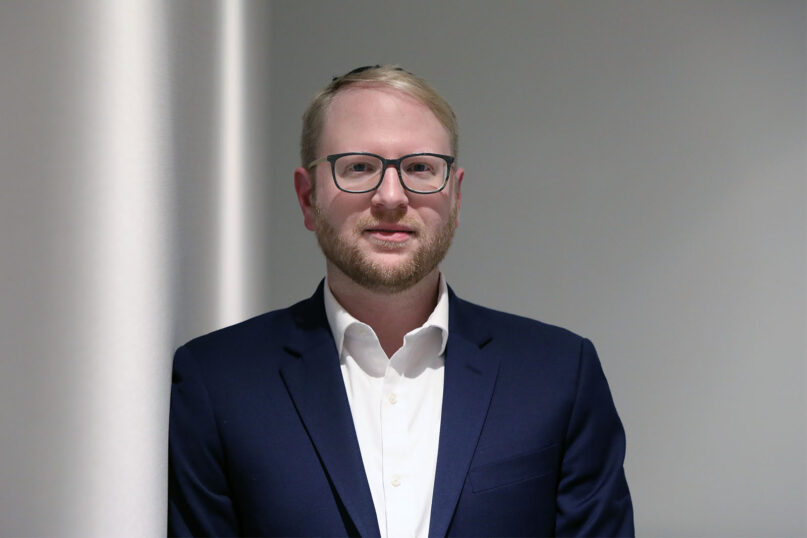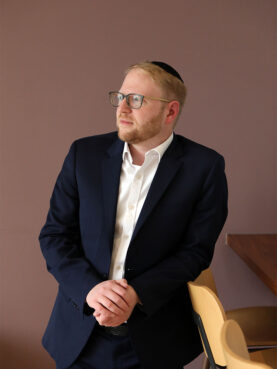(RNS) — Soon after a report from New York City’s Department of Education came out earlier this summer, finding that 18 Jewish yeshivas broke the law by failing to provide their students with an adequate secular education, Naftuli Moster got to work.
The report named only four of the 18 yeshivas. Moster wanted to name them all.
It took a week of reporting, but his fledgling online news site, Shtetl: Haredi Free Press, published the names and addresses of the failing yeshivas. No other news outlet, including any Jewish one, did so.
Haredi schools, which receive hundreds of millions of dollars in public money annually, prioritize religious education over secular studies.
Failing yeshivas is a subject Moster is passionate about. Born into the Belz Hasidic sect, he took six years to complete an undergraduate degree, something Moster attributes to his subpar yeshiva education. A year before he finally graduated in 2013, he founded Young Advocates for Fair Education, or Yaffed. The nonprofit succeeded in getting city and state education officials to launch multiple probes of the yeshiva educational system. That eventually led to a New York Times investigation that concluded that generations of New York City-based children have been systematically denied a basic education.
It also led the towheaded 37-year-old activist to discover journalism. Late last year Moster left Yaffed, and five months ago, with the backing of a few anonymous donors, launched Shtetl. (The Yiddish word means a small Jewish town.)
RELATED: The case for secular education in Hasidic schools
The new media venture is small, with only three full-time positions and a smattering of interns, but as its editor-in-chief, Moster, a polite, mild-mannered man, is nothing if not tenacious.
His advocacy work convinced him there’s a need for an independent news outlet that holds Haredi leaders and institutions — and especially the rabbinic establishments — accountable for the lives of tens of thousands of their adherents.
“The Haredi community, like every other community, deserves a free media that operates independently of the leadership,” Moster said. “Otherwise, you’re just sitting in an echo chamber and with a bunch of (rabbinic-controlled) media saying, ‘We’re great, we have no problems in our community and everyone outside is out to get us.’ It makes it extremely hard to bring change.”
So far, Shtetl has had a number of eye-catching stories. It reported on the grand rabbi of the Satmar Hasidic group, Aaron Teitelbaum, boasting in a recorded speech that he got two New York state lawmakers to introduce a bill that would weaken oversight of yeshiva schools by allowing yeshivas to form their own private accreditation agencies.
Shtetl also reported on a Rockland County Haredi community’s ad campaign for a family court judge who would be more likely to award custody to Haredi families in child sex abuse cases. The judge won the primary.
And just last week, the fledgling outlet reported on a new affordable housing development for Satmar Jews in Kiryas Joel, a community in upstate New York. Those eligible to apply for a home? Families “who send their kids to our schools and who are behaving appropriately.”
Even with the best of stories, starting an online media company is a challenging proposition.
Gary Rosenblatt, a former editor and publisher of The Jewish Week of New York, which caters mostly to non-Haredi Jews, concedes it’s an uphill climb.
“There are hardly any business models left, certainly for Jewish media,” he said.
Beyond the financial and marketing challenges is an even more existential question: Can a news outlet focused on the Haredi community build an audience?
Haredi Jews (the word comes from the Hebrew word “hared,” meaning “to tremble”) have erected strong and seemingly impregnable barriers to any outside influence.
There are more than a dozen Haredi sects in New York and New Jersey, most with their own rabbinic dynasties. They all share a strict adherence to a particular interpretation of the religious commandments in the Torah and halakhah — Jewish law and practice.
Haredi Jews live in every borough of the city and have in recent decades begun to settle in the surrounding counties of Rockland, Orange, Westchester and Sullivan, as well as fast-growing Lakewood, N.J. There are no good estimates of their numbers because they do not cooperate with demographer surveys.
But in Brooklyn alone — where there’s the Chabad-Lubavitch sect in Crown Heights, Satmar in Williamsburg and Belz in Borough Park — some estimates put their numbers as high as 300,000.
A subset of Orthodox Judaism, Haredi Jews ( including most Hasidic Jews, another Haredi segment), speak Yiddish. Some have only a rudimentary knowledge of English. Most homes don’t have TVs.
And while the outside world has begun to creep in through the internet, its usage is frowned on by many rabbinic authorities and allowed mainly if it is a requirement for employment. Some yeshivahs insist parents install internet filtering software on their smartphones or laptops as a condition of their child’s admission to the school.
Moster, who wears a yarmulke and grows a beard (though he keeps his trim), is a product of that world and still identifies with it.
He grew up the ninth sibling in a family of 17 children in Borough Park. At home everyone spoke Yiddish, but his mother and sisters knew some English, as girls and women in the community often receive more secular education at school.
After high school and a stay at a yeshiva in Israel, Moster decided to enroll at a professional school tailored to Orthodox Jews that offers an associate’s degree. He barely made it in. He had no high school diploma and no GED since most yeshivas for boys don’t offer those. The college required him to take eight credits of remedial English — none of which counted toward a degree.
Moster said he was completely unprepared for any academic study. “I’d never heard the word semester. I never heard about GPA, credits, major, minor.”
He remembers taking a psychology class where the textbook included a unit on memory. It asked students: “Where were you when the O.J. Simpson verdict was announced?”
Moster had no clue who O.J. Simpson was.
Working as a forklift operator at a warehouse in Newark and living in Staten Island, he decided to transfer to CUNY College of Staten Island, where he finally completed his undergraduate degree. He then went on to earn a Master of Social Work degree from Hunter College.
All along, he faced resistance from his family and religious community for deviating from the prescribed path for young men.
“What you’re supposed to be doing at that stage in your life is just sitting and learning Torah — not secular stuff, which could potentially involve heresy,” he said.
On days he had classes, he would walk past the college entrance and then turn around and walk back to make sure nobody he knew spotted him there.
Since graduation, his 10-year advocacy for educational reform as executive director of Yaffed only deepened the divide between Moster and his religious community.
Moster has been ostracized and treated with scorn by fellow Haredi Jews.
“I was like a Jewish mother telling him he had to contact the police because he, he had gotten death threats,” said Anita Altman, a board member and former president of Yaffed. “We were accused of being antisemites, causing a holocaust for Jews — really horrible, ugly stuff.”
An observant Jew who is married with two children (his wife, Miriam, also comes from the Haredi world and is completing a Ph.D. in sociology), he now prays at a couple of modern Orthodox synagogues in New Jersey, where the couple recently bought a house.
Moster is one of a growing number of Orthodox Jews who have emerged in the past decade and shed light on the separatist religious communities. There’s “My Unorthodox Life,” a reality series about the rise of Julia Haart from a Monsey, New York, housewife to a fashion diva. There was the four-part Netflix series “Unorthodox,” a drama about a Haredi woman’s escape from an unhappy arranged marriage, based on a memoir by Deborah Feldman. There’s even a phrase to describe the state of a Jew who has left the Haredi, or more generally Orthodox, way of life — “off the derech.”
But Moster hasn’t left. He still sees himself as a devout Jew and envisions his news outlet as a resource by and for Haredi Jews — even as it’s independent of any particular sect.
Digital technology is reshaping Haredi lives and upending traditional hierarchies. Despite their rabbis’ objections, many Haredi Jews have bought smartphones and have become schooled in social media, forming Yiddish-language chat rooms and other spaces to communicate (typically WhatsApp and Telegram).
David Myers, a professor of history at UCLA and the co-author of “American Shtetl: The Making of Kiryas Joel, a Hasidic Village in Upstate New York,” calls it a kind of unwitting assimilation.
And although the majority of Haredi Jews harshly criticized The New York Times’ investigation of Hasidic yeshivas, with many calling it antisemitic, there are others who are more open to criticism, even if not publicly.
“There are, at the other end of the spectrum, those who my colleague Ayala Fader called in her book ‘hidden heretics,'” said Myers. “These are people who outwardly live Haredi lives. But inside their brains and cognitive world they live online and have a community of conversation partners that may be comprised of people who have left the Haredi community.”
These might be the kind of readers who gravitate to Shtetl.
Five months in, the news site has only 1,400 followers on Twitter and fewer than 300 on Facebook, but Moster is no stranger to hardship and he is beginning to learn the realities of the sink-or-swim journalism ecosystem.
To keep down costs, Shtetl operates as a virtual newsroom. It has no advertising, but recently a donation button was added to the site and a newsletter signup block.
“I remind people, real journalism isn’t here to be liked,” Moster said. “We’re here to provide information, which can sometimes be hard to hear. And we’re here to hold powerful people and leaders accountable to the people they are supposed to serve, and in the Haredi context, those leaders have convinced their followers that a story in the press that is critical of the leaders is by extension critical of the community. That’s just false.”
RELATED: Appealing to Orthodox Jews, Israeli media remove women from view







